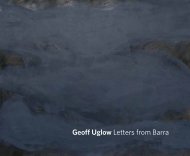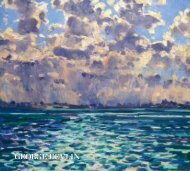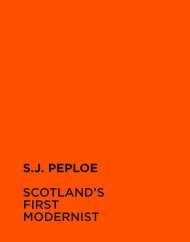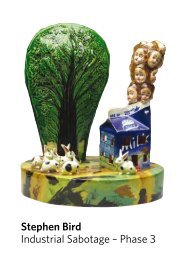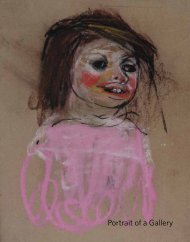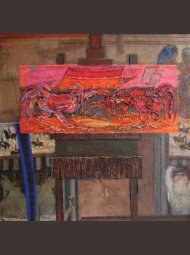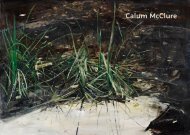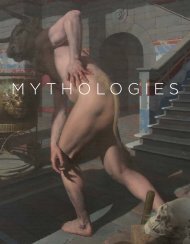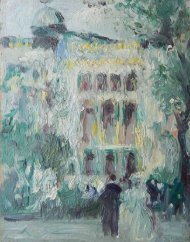Download a PDF of the exhibition catalogue - The Scottish Gallery
Download a PDF of the exhibition catalogue - The Scottish Gallery
Download a PDF of the exhibition catalogue - The Scottish Gallery
You also want an ePaper? Increase the reach of your titles
YUMPU automatically turns print PDFs into web optimized ePapers that Google loves.
<strong>of</strong> enlightened collectors was paralleled by an increase in <strong>the</strong> number <strong>of</strong> artists working<br />
in Scotland and in <strong>the</strong> number <strong>of</strong> works which <strong>the</strong>y produced. It was <strong>the</strong> dealers who<br />
brought <strong>the</strong>se two groups toge<strong>the</strong>r and provided an outlet for <strong>the</strong> artists’ work.<br />
In Glasgow, La Société des Beaux-Arts at 232 West George Street represented<br />
<strong>the</strong> ‘Glasgow Boys’, putting on <strong>exhibition</strong>s for Edward Atkinson Hornel (1864–1933),<br />
George Henry (1858–1943) and Joseph Crawhall (1861–1913), and as early as 1891 an<br />
<strong>exhibition</strong> was held <strong>of</strong> <strong>the</strong> works <strong>of</strong> Degas and o<strong>the</strong>r Post-Impressionists. In 1906 Reid<br />
took up McTaggart and, according to Caw, ‘put up prices at once by trying to secure<br />
almost every fine picture by that painter which “came on <strong>the</strong> market”.’ Two letters, <strong>the</strong><br />
first written on 2nd February 1911 by Reid and <strong>the</strong> second written on 21st February<br />
<strong>the</strong> same year by George Proudfoot, Peter McOmish Dott’s partner in <strong>The</strong> <strong>Scottish</strong><br />
<strong>Gallery</strong>, illustrate <strong>the</strong> different approaches by <strong>the</strong> two dealers and also demonstrate <strong>the</strong><br />
competition for business between <strong>the</strong> two galleries. Both dealers were interested in<br />
selling works by McTaggart entitled Cornfields to Blyth. <strong>The</strong> picture in <strong>The</strong> <strong>Scottish</strong> <strong>Gallery</strong><br />
is documented as being 52 by 35 inches. <strong>The</strong> picture in Glasgow is referred to in George<br />
Proudfoot’s letter: ‘Mr Reid’s snow picture is 54 by 35 inches and is in a ra<strong>the</strong>r heavier<br />
frame than our picture.’ Reid demands ‘promised payment’ and a picture by George<br />
Houston for his painting: ‘You are remembering you promised me £50 at Martinmas.<br />
Also I would very much like to have <strong>the</strong> Houston now.’ Proudfoot, in contrast, is more<br />
sympa<strong>the</strong>tic to Blyth’s position: ‘You are quite right not to decide about <strong>the</strong> McTaggart<br />
too hurriedly. It is an important purchase and one you should be sure about.’<br />
<strong>The</strong> outcome <strong>of</strong> <strong>the</strong> competition is documented in a purchase receipt <strong>of</strong> 3rd<br />
April 1911, from <strong>The</strong> <strong>Scottish</strong> <strong>Gallery</strong>: Cornfields Midlothian by McTaggart was sold to<br />
Blyth for £285 along with <strong>the</strong> purchase <strong>of</strong> a landscape by George Houston. <strong>The</strong> difference<br />
between <strong>the</strong> characters <strong>of</strong> <strong>the</strong> dealers is fur<strong>the</strong>r illustrated in a letter dated June 1917,<br />
from Reid to Blyth: ‘If you are serious in thinking about <strong>the</strong> Xmas Morning <strong>the</strong>re is no use<br />
in talking nonsense to us.’<br />
McTaggart was born at Aros, by Machrihanish on <strong>the</strong> Mull <strong>of</strong> Kintyre in 1835<br />
and came to Edinburgh when he was 16. He was one <strong>of</strong> a group <strong>of</strong> students that included<br />
Hugh Cameron, George Reid, George Paul Chalmers and William Quiller Orchardson,<br />
who studied under Robert Scott Lauder between 1852 and 1861. Under Lauder’s tuition,<br />
<strong>the</strong> use <strong>of</strong> colour – particularly <strong>the</strong> use <strong>of</strong> different tones and gradations <strong>of</strong> light and<br />
colour – was given equal emphasis to draughtsmanship.<br />
McTaggart became a ‘<strong>Scottish</strong> Impressionist’, leaving behind <strong>the</strong> typically<br />
Victorian subject matter and finely detailed technique apparent in his production until<br />
<strong>the</strong> 1880s in favour <strong>of</strong> broad application <strong>of</strong> oil paint and sparkling landscapes made en<br />
plein air, as much about light as location. It is not hard to see how <strong>the</strong>se works would<br />
have appealed to Blyth. At <strong>the</strong>ir best his paintings elicit a strong, emotional response akin<br />
to orchestral music, quite apart from <strong>the</strong>ir ‘subject matter’ which became increasingly<br />
irrelevant. Besides Turner <strong>the</strong>re is no o<strong>the</strong>r example <strong>of</strong> a British painter with such<br />
ambition, matched by sheer painterly ability, who is able to express his wonder in front<br />
<strong>of</strong> his landscape subject and invest it with such power and universal relevance.<br />
Stanley Cursiter pays tribute to Peter McOmish Dott, who was senior partner<br />
by <strong>the</strong> time Blyth began to collect. He was a man ‘<strong>of</strong> fine taste, generous and warm<br />
hearted and a real friend to many <strong>of</strong> <strong>the</strong> artists he encouraged and supported’. And this<br />
sympathy must have won <strong>the</strong> trust <strong>of</strong> <strong>the</strong> young enthusiast. Dott was uniquely qualified to<br />
introduce McTaggart, by <strong>the</strong>n <strong>the</strong> grand old man <strong>of</strong> <strong>Scottish</strong> painting. In 1900 he agreed<br />
to purchase 29 works by McTaggart for £5,000 and <strong>the</strong> pictures were subsequently<br />
exhibited in Glasgow, Edinburgh and Dundee. It is doubtful whe<strong>the</strong>r Blyth would have<br />
seen this <strong>exhibition</strong> but Dott later sent Blyth <strong>the</strong> guide he had written, entitled Technical<br />
8



